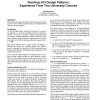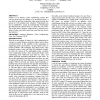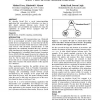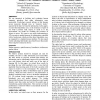CHI
2002
ACM
15 years 1 months ago
2002
ACM
Tangible programming elements offer the dynamic and programmable properties of a computer without the complexity introduced by the keyboard, mouse and screen. This paper explores ...
CHI
2002
ACM
15 years 1 months ago
2002
ACM
Many applications have cluttered dialogs that require users to make complicated settings. Some settings even determine the availability and state of other settings, creating inter...
CHI
2002
ACM
15 years 1 months ago
2002
ACM
This paper summarizes the findings of teaching and evaluating two courses within computer science curricula that dealt with HCI Design Patterns.
CHI
2002
ACM
15 years 1 months ago
2002
ACM
In this paper we discuss a pilot usability study using wireless Internet-enabled personal digital assistants (PDAs). We compared usability data gathered in traditional lab studies...
CHI
2002
ACM
15 years 1 months ago
2002
ACM
GAZE-2 is an attentive video conferencing system that conveys whom users are talking to by measuring whom a user looks at and then rotating his video image towards that person in ...
CHI
2002
ACM
15 years 1 months ago
2002
ACM
This paper presents a novel approach and interface for encouraging children to tell and act out original stories. "Dolltalk" is a toy that simulates speech recognition b...
CHI
2002
ACM
15 years 1 months ago
2002
ACM
We found that established display design guidelines for focal images cannot be extended to images displayed as a secondary task in a dual-task situation. This paper describes an e...
CHI
2002
ACM
15 years 1 months ago
2002
ACM
We describe Social Net, a novel interest-matching application that uses patterns of collocation, over time, to infer shared interests between users. Social Net demonstrates new po...
CHI
2002
ACM
15 years 1 months ago
2002
ACM
We are interested in building and evaluating human computer interfaces that make information more memorable. Psychology research informs us that humans access memories through cue...
CHI
2002
ACM
15 years 1 months ago
2002
ACM
Users interacting with front-projected displays often work between the projector and the display surface. This causes undesirable projection on the user as well as temporary blind...




